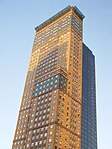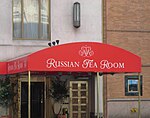New York City Center
Clubhouses on the National Register of Historic Places in ManhattanConcert halls in New York CityCulture of ManhattanDance venues in the United StatesFormer Masonic buildings in New York (state) ... and 8 more
Masonic buildings completed in 1923Midtown ManhattanMoorish Revival architecture in New York CityNew York City Designated Landmarks in ManhattanShrinersSpecial Tony Award recipientsTheatres in ManhattanTheatres on the National Register of Historic Places in Manhattan

New York City Center (previously known as the Mecca Temple, City Center of Music and Drama, and the New York City Center 55th Street Theater) is a 2,257-seat Moorish Revival theater at 131 West 55th Street between Sixth and Seventh Avenues in Midtown Manhattan, New York City, one block south of Carnegie Hall. City Center is a performing home for several major dance companies as well as the Encores! musical theater series and the Fall for Dance Festival. The facility houses the 2,257 seat main stage, two smaller theaters, four studios and a 12-story office tower.
Excerpt from the Wikipedia article New York City Center (License: CC BY-SA 3.0, Authors, Images).New York City Center
6½ Avenue Pedestrian Arcade, New York Manhattan
Geographical coordinates (GPS) Address Website External links Nearby Places Show on map
Geographical coordinates (GPS)
| Latitude | Longitude |
|---|---|
| N 40.763888888889 ° | E -73.979444444444 ° |
Address
New York City Center (City Center 55 Street Theater)
6½ Avenue Pedestrian Arcade
10106 New York, Manhattan
New York, United States
Open on Google Maps









